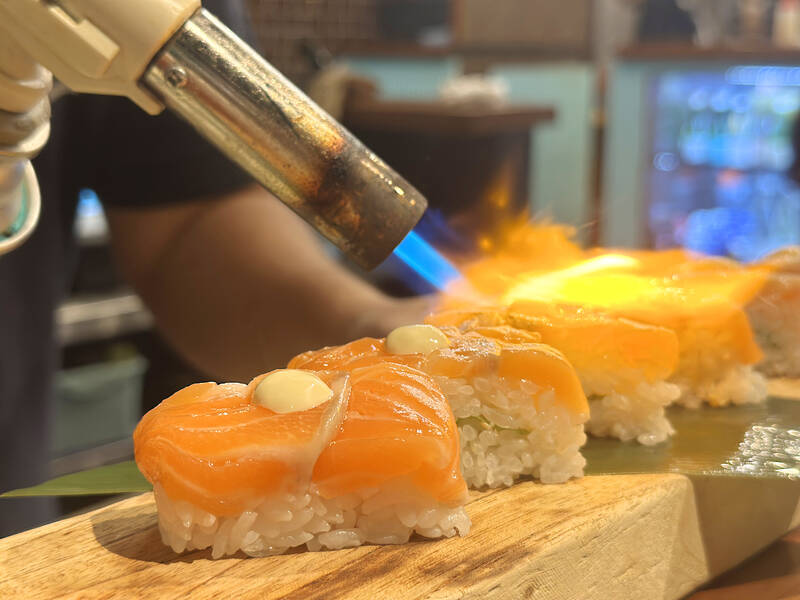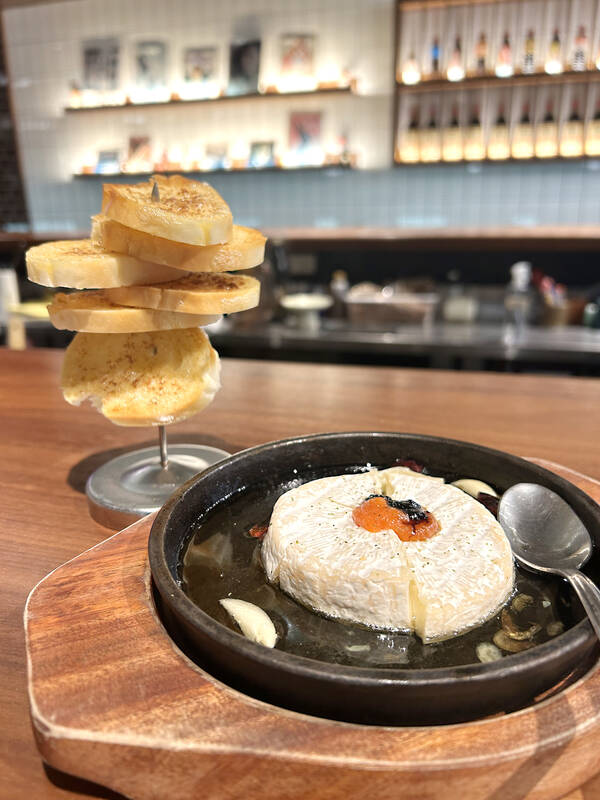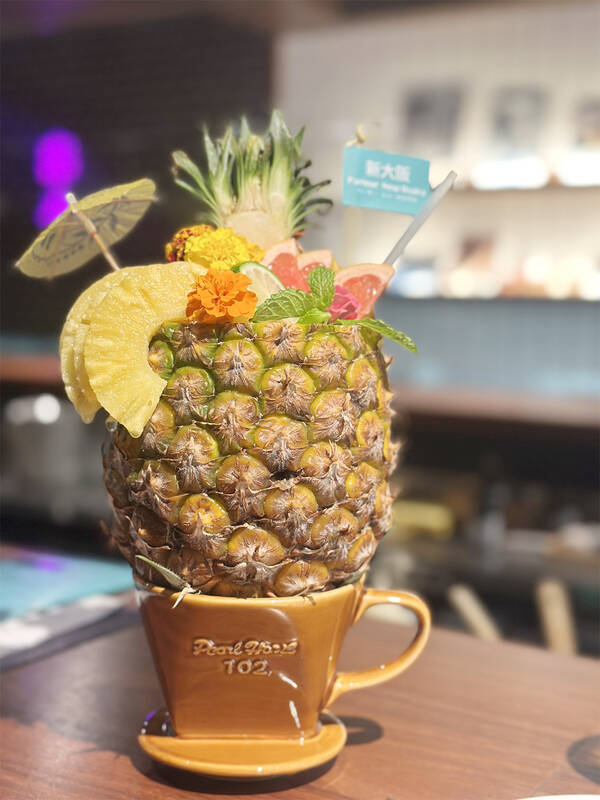Japanese is on the menu tonight. Yes, Taipei may be sprawling with cozy Izakayas and infamous ramen franchises, but for anyone in the market for authentic Japanese cuisine with both style and an inviting atmosphere, Parlor New Osaka offers a fresh, elevated take on our northeastern neighbor’s classics, its vibe nestled between cozy old-school class and swanky cocktail bar.
The walls are plastered with kitsch Japanese nostalgia; a retro pinball game, neon-lit signs and cutouts of Japanese pinup dolls. But up at the central wraparound bar, the space steers more sophisticated: bottles of whiskey and elegant glasses backlit with a warm orange glow, suited patrons and after-work dates sharing Japanese-style tapas over cocktails.
The menu offers the same dichotomy of homely retro and chic cuisine.

Photo: Hollie Younger
We find Osaka staples like Battera, pressed sushi, and kushikatsu, deep-fried skewers of anything the chef desires, served with a vat of inky dipping sauce. Then we have Japanese classics of udon Carbonaras and glistening sashimi. But what we came for are the clever little small plates, like the Camembert with spicy cod roe ajillo, and modern fusions like the New Osaka sangria (NT$280). Subtle nods to Spain with flawless Japanese execution.
The ever-changing menu du jour treats us to yet more indulgent offerings, from seared beef tongue to flounder fin sushi.
Arriving at our designated spot at the bar, I’m delighted to find a singular white-shelled egg decorated with a hand-drawn caricature and my name, a cheeky replacement for the oh-so-pedestrian “reserved” sign.

Photo: Hollie Younger
Opposite, the chef whips out a blowtorch — are these now in every Taipei bistro? — and chars the fleshy sashimi atop their signature Battera sushi, an Osaka invention of cuboidal rice pressed in bamboo molds, for which they swap the classic mackerel or seared salmon. The tone has been set.
A sucker for a gimmick, I spot a giant cocktail served in an entire hollowed-out pineapple and get to ordering. It’s for one, I’m reassured, as three helpings of my five-a-day arrive in a pineapple almost as large as my head.
This is the “pineapple tiki” variant of the New Osaka fruit punch (NT$500); if pineapple’s not your thing, rest assured they can also shove a liter of cocktail into the husk of a honeydew melon.

Photo: Hollie Younger
Despite the hoopla of the presentation, it’s actually a darned good cocktail, essentially a Pina Colada that’s heavy on the pina, and the abundance of fruit atop makes for a good palette cleanser throughout the sitting.
With the welcomed smell of buttery garlic bread wafting from my left, I do as any wise diner does and point unabashedly at the couple beside us with an “I’ll have that.” This is, of course, the aforementioned Camembert & spicy cod roe ajillo (NT$280) served with toasted garlic bread.
In a mini-Mediterranean-style cast iron pan, an oozy and overindulgent wheel of Camembert is bathed in butter, garlic and chili and topped with a spicy cod roe dressing. Clearly unafraid of over-the-top presentation, the garlic bread comes skewered in what looks like a spike for receipts.

Photo: Hollie Younger
Now, I didn’t think I’d recommend a Japanese restaurant for Camembert, but this is ridiculously good. Japanese cuisine loves butter as much as the next, and this is served with lashings; it’s gooey, and moreish and that mentaiko really gives it a little something-something.
The second must-order would be the Carbonara-inspired sea urchin “carbonala” udon (NT$430), reasonably priced for the generous helpings of luxury ingredients with uni, roe and sweet flaky crab meat piled atop. Italians look away, but it’s a creamy, fishy and all-round delightful Asian carbonara.
In the name of authenticity, we get the Chef’s choice of five kinds assorted kushikatsu (NT$200), which today is king oyster mushroom, squid, chicken, takoyaki — batter filled with grilled octopus — and tamagoyaki, or Japanese omelet. We dip in the Worcestershire-spiked soy sauce with satisfaction.
On the specials menu, we choose the grilled beef tongue with scallion sauce (NT$450), always a fine choice of protein. Just lightly grilled on the exterior, the slices remain juicy pink and medium rare, complimenting the zing of the scallions and a freshly squeezed lemon.
Luxury ingredients at reasonable prices, a space elegant yet welcoming and a menu that caters to both the authentic and the inventive — Parlor New Osaka’s whimsical presentations and impressive cocktail list cements it as a must-visit Japanese offering.

Most heroes are remembered for the battles they fought. Taiwan’s Black Bat Squadron is remembered for flying into Chinese airspace 838 times between 1953 and 1967, and for the 148 men whose sacrifice bought the intelligence that kept Taiwan secure. Two-thirds of the squadron died carrying out missions most people wouldn’t learn about for another 40 years. The squadron lost 15 aircraft and 148 crew members over those 14 years, making it the deadliest unit in Taiwan’s military history by casualty rate. They flew at night, often at low altitudes, straight into some of the most heavily defended airspace in Asia.

Many people in Taiwan first learned about universal basic income (UBI) — the idea that the government should provide regular, no-strings-attached payments to each citizen — in 2019. While seeking the Democratic nomination for the 2020 US presidential election, Andrew Yang, a politician of Taiwanese descent, said that, if elected, he’d institute a UBI of US$1,000 per month to “get the economic boot off of people’s throats, allowing them to lift their heads up, breathe, and get excited for the future.” His campaign petered out, but the concept of UBI hasn’t gone away. Throughout the industrialized world, there are fears that

Taiwan’s democracy is at risk. Be very alarmed. This is not a drill. The current constitutional crisis progressed slowly, then suddenly. Political tensions, partisan hostility and emotions are all running high right when cool heads and calm negotiation are most needed. Oxford defines brinkmanship as: “The art or practice of pursuing a dangerous policy to the limits of safety before stopping, especially in politics.” It says the term comes from a quote from a 1956 Cold War interview with then-American Secretary of State John Foster Dulles, when he said: ‘The ability to get to the verge without getting into the war is

Like much in the world today, theater has experienced major disruptions over the six years since COVID-19. The pandemic, the war in Ukraine and social media have created a new normal of geopolitical and information uncertainty, and the performing arts are not immune to these effects. “Ten years ago people wanted to come to the theater to engage with important issues, but now the Internet allows them to engage with those issues powerfully and immediately,” said Faith Tan, programming director of the Esplanade in Singapore, speaking last week in Japan. “One reaction to unpredictability has been a renewed emphasis on